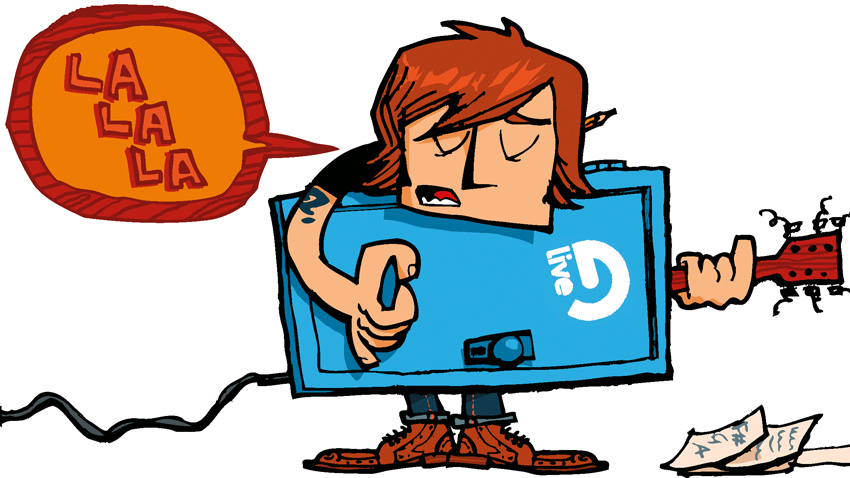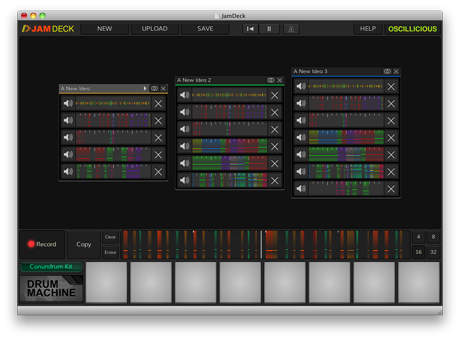Is your DAW the wrong place to write your music?
We explore the alternatives to composing in your production software

Your DAW is amazing. It's an end-to-end production environment that enables you to create music of professional quality. What's debatable, though, is whether or not it's the best place for you to actually write your music, as opposed to 'producing' it.
Even the most seasoned of tunesmiths can feel a little intimidated by an empty timeline or clip grid, and with good reason. For many of us, getting a song started is one of the most difficult parts of the creative process, and at times, it can feel like your DAW is more of a hindrance to this task than a help.
But why? We spoke to Albert Santoni, lead developer at software company Oscillicious, who recently released a new application called Jamdeck (previously known as SongStarter). This is designed to serve as an alternative to your DAW when you're starting a song. But why does it need to exist at all?
Too technical, too many options
"There are two main flaws in a standard DAW when it comes to sitting down and trying to write a song," says Santoni. "The first is that, because most DAWs evolved out of MIDI sequencers, writing a song involves a lot of transport management, cutting of recordings and manual editing. These technical tasks can become a bit of a chore if the goal is to get in the zone and write a song. A standard DAW draws too much attention away from the idea of just jamming and experimenting with melodies.
"The second flaw is that DAWs have become a Pandora's box. With so many instruments, presets and parameters available, it's very easy to get sidetracked from songwriting and lose sight of your original idea. The quest to find that perfect synth preset can be a real distraction from actual songwriting. Sometimes we forget that even the best sound design and mixing cannot make a melody great."
These are valid points, certainly, but the obvious follow-up question to ask Santoni is: what makes Jamdeck different?

"Jamdeck differs from a standard DAW in that it aims to be much closer to the experience of picking up a real instrument and jamming, yet still have the advantages of software," explains Santoni. "Jamdeck gives the songwriter an environment where they can be recording and building on an idea within seconds of launching the program. With the focus being solely on recording melodies and rapid experimentation, Jamdeck pulls you into songwriting in a way that no other software does."
Want all the hottest music and gear news, reviews, deals, features and more, direct to your inbox? Sign up here.
It's interesting that Santoni notes Jamdeck's 'uniqueness' because, earlier this year, we heard of another application that is conceptually similar, at least in the most fundamental sense.
At Summer NAMM 2012, A.I.R. Studios launched Ignite, a new piece of software that will ship with M-Audio's forthcoming Axiom A.I.R. MIDI controller range. Speaking to MusicRadar, company representative Samara Winterfield described Ignite as "a product for anyone who's tried to use a DAW and has banged their head against the wall so many times that they couldn't see straight any more. The goal here is to allow musicians to capture their ideas in ways that are intuitive and inspiring.
"It's very easy to create a session [in Ignite], and we have a lot of hardware/software integration so that when you connect any M-Audio keyboard, the software automatically detects which piece of hardware is connected and maps it. It's very easy to get started - you don't have to worry about setting anything up."

At the heart of Ignite is the Song Arranger, which Winterfield describes as "a very organic space. There are no grid or tracks or lanes - you can move ideas around in whatever way you want. Musicians don't want to worry about how they're going to get all the tracks in their song placed correctly. They just want to be able to record ideas and create songs, and with the Song Arranger they can do that very easily."
It's hard to say exactly how Jamdeck and Ignite compare - the latter hasn't been released yet - but this more 'freeform' approach to composition certainly has its merits. What's more, the developers of both applications are keen to point out that once you've done what you need in them, you can take your ideas elsewhere for further development.
"We really see Ignite as a DAW companion and not a competitor," says Winterfield. "We want folks to use this as a musical sketchpad; as a way to get their ideas down before they vaporise into thin air. From there you can take them into any DAW, where you can continue the production process."
Back to basics
But what of the argument that adding another application into the music-making process just adds another layer of complication? We put this question to Santoni, who thinks users should consider Jamdeck for "the same reason many musicians still write songs on pianos or guitars. The ability to instantly get a jam going and experiment without worrying about coming up with a finished song is liberating for your creativity. And when a song is laid bare, when there are no sound design or production techniques to hide it behind, it's easier to write a better melody."
To be fair to DAW developers, most DAWs are now far more approachable than they once were, and many give you 'quick start' options that are helpful for getting ideas down quickly (song templates that contain a selection of preloaded instruments and audio tracks, for example).
What's more, if you can discipline yourself to separate the songwriting and production processes, a DAW can help you with both of them.
There are certainly software alternatives to your DAW when you're at the composing stage, then - the likes of RapidComposer and even NI's Maschine are also worth investigating if you want to come at songwriting from a different angle - but what about looking beyond your computer entirely? Whether you're consciously aware of it or not, there's a chance that, deep down, you associate your Mac or PC with task-orientated work rather than creativity, so stepping away from it might prove to be surprisingly beneficial.
Of course, if you play an instrument, there's a lot to be said for coming up with ideas on that. You're likely to stumble upon tasty hooks, licks and chord progressions just by jamming on your own - or better yet, with other people.
"Whether you're consciously aware of it or not, there's a chance that, deep down, you associate your Mac or PC with task-orientated work rather than creativity."
If traditional instruments aren't your thing, think about the other music-making tools you have at your disposal - particularly the one that's sitting in your pocket. While mobile music-making apps are getting ever more complete, their best function is arguably as scratchpads for capturing ideas whenever inspiration strikes.
This is why it's so important that these apps have comprehensive file export options. When it was launched, Propellerhead's Figure enabled you to do nothing more than create a simple groove - it couldn't be sent anywhere or even saved. As such it felt like more of a toy than a tool, but now that you can archive projects and send them to iTunes, it's become a properly useful song starter.
This article originally appeared in issue 185 of Computer Music magazine.


Computer Music magazine is the world’s best selling publication dedicated solely to making great music with your Mac or PC computer. Each issue it brings its lucky readers the best in cutting-edge tutorials, need-to-know, expert software reviews and even all the tools you actually need to make great music today, courtesy of our legendary CM Plugin Suite.
